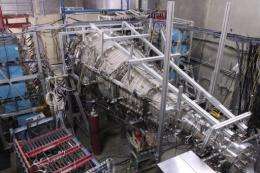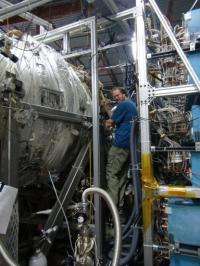Canadian firm bids to commercialize fusion reactor

In the race against world governments and the wealthiest companies to commercialize a nuclear fusion reactor, a small, innovative Canadian firm is hoping to bottle and sell the sun's energy.
In a laboratory in this Pacific Coast city, General Fusion physicists and engineers in bright red smocks are busy assembling an experimental reactor.
They hope to test a prototype in 2014 and eventually become the first to commercialize the technology, offering a safe, cheap, pollution-free and virtually inexhaustible source of energy.
"What we're trying to do is build the technology that can make the power that drives the sun, make it here on earth," said Michael Delage, General Fusion's vice president.
It is no easy task.
But success is crucial given the harm predicted from the continued widespread burning of fossil fuels, and the uncertain outcome of a 12-day round of UN talks on climate change that got underway on Monday in Durban, South Africa.
The UN Framework Convention on Climate Change (UNFCCC) gathers 194 countries under a process launched under the 1992 Rio Summit.
Topping the agenda is the fate of the Kyoto Protocol, the only global pact that sets targets for reducing greenhouse gas emissions, blamed for global warming. And some have seen nuclear power as a way forward.
Nuclear energy is created by one of two ways. The first is fission, or splitting the nucleus of an atom, which is used in hundreds of nuclear reactors around the world that produce about 15 percent of our electricity.
Fusion squeezes two or more lighter atoms together producing one heavier atom plus a lot of heat. This can only be done at 150 million degrees Celsius and that takes a lot of power.

The trick is to get more energy out of the reaction than is put into it, in a controlled way.
An Australian physicist was the first to fuse heavy hydrogen isotopes in a laboratory in 1932, replicating the process that powers stars.
Research into fusion for military purposes began a decade later as part of the Manhattan Project and would lead to the testing of a crude hydrogen bomb in 1952.
General Fusion plans to inject two rings of superheated plasma into a metal sphere containing a vortex of molten lead and lithium then hit it with a wave of energy made by about 200 pneumatic pistons squashing the atoms together.
The heat produced would be used to spin turbines to produce electricity.
"Our big advantage is finding a way to harness these existing technologies -- that we understand -- to go at this challenge of fusion, and therefore be able to do it in a shorter timescale on less money," said Delage.
Governments have already spent billions of dollars since the 1950s on ambitious fusion projects for civilian purposes -- and so far they have come up short. Its potential therefore remains uncertain.
Hopes of seeing thermo-nuclear fusion become a source of energy by 2050 lie primarily with ITER, the world's largest and most advanced experimental nuclear fusion reactor. Construction has started in the south of France in 2007 and it is expected to be tried in 2019.
The idea to develop a new energy source to replace depleting supplies of fossil fuels was hatched at a superpowers summit 25 years ago.
The consortium of China, the European Union, India, Japan, South Korea, Russia and the United States -- representing half of the world's population -- last week announced the lifting into place of a last ITER module to close "the most complex and extravagant ring ever manufactured."
General Fusion admits its chances of success are slim -- but backers believe in its proposal, and are pouring CAN$30 million into the project.
"In the overall scheme of how much money is involved here it's really not that much money given the potential payoff that could be had," said Paul Austin of Sustainable Development Technology Canada.
If all goes as planned General Fusion hopes to have a working reactor on the market by the end of the decade. But even if the technology works some remain skeptical of its marketability.
"The central challenge is still that fossil fuels -- getting them out of the ground and burning them -- is still so cheap to do that there is not an adequate incentive to invest in renewables or other low carbon technologies," said Matt Horne, director of the Pembina Institute.
Coal and gas power continue to dominate the energy landscape. And for now, anyway, star power is still a distant dream.
(c) 2011 AFP


















